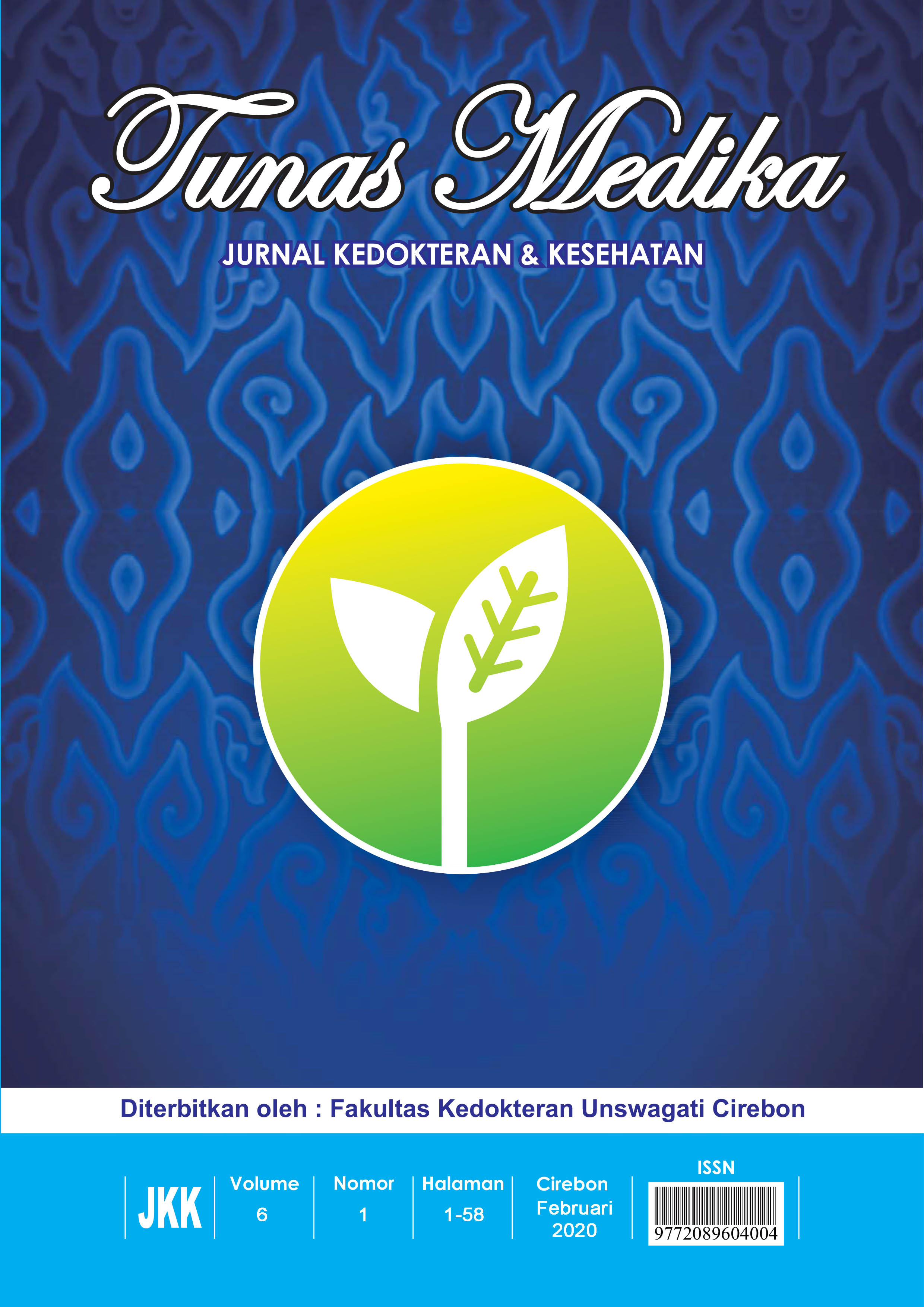Faktor –Faktor Non Genetik yang Mempengaruhi Disabilitas Intelektual di SLB Kota Cirebon Tahun 2017 (Studi Di SLB C Pancaran Kasih Dan SLB C Budi Utama
DOI:
https://doi.org/10.33603/tumed.v6i1.3260Abstract
ABSTRAK
Â
Latar Belakang: Disabilitas merupakan keterbatasan/ kekurangan kemampuan untuk melakukan suatu aktivitas pada tingkat personal dan didefinisikan sebagai nilai kecerdasan kira-kira 70 atau lebih rendah, insidensi disabilitas di provinsi jawa barat mencapai 12,7% dengan rerata skor 22,88%. faktor risiko yang sering menyebabkan disabilitas intelektual biasanya terjadi pada masa prenatal, perinatal dan postnatal, diantaranya jumlah gestasi pada saat hamil, berat badan lahir rendah (BBLR), usia persalinan, usia ibu dan usia ayah. Tujuan: Untuk mengetahui pengaruh antara berat badan lahir rendah, prematuritas, jumlah paritas, usia ibu dan usia ayah terhadap disabilitas intelektual di SLB Kota Cirebon tahun 2017. Metode: Penelitian ini menggunakan desain penelitian observasional analitik dengan desain case control. Sampel penelitian sebanyak 79 orang pada kelompok kasus dan 79 orang pada kelompok kontrol. Hasil: Hasil dari penelitian ini didapatkan bahwa Berat badan lahir rendah (pvalue = 0.000), Usia persalinan (pvalue = 0.000), Paritas (pvalue = 0.001), Usia Ibu (pvalue = 0.000) dan Usia ayah (pvalue = 0.000) mempengaruhi kejadian disabilitas intelektual di kota cirebon dengan faktor yang paling berpengaruh yaitu status usia pada saat ibu memulai kehamilan (pvalue= 0.001). Simpulan: Pada penelitian ini Berat badan lahir rendah, usia persalinan (preterm), Paritas, usia ibu dan usia ayah mempengaruhi kejadian disabilitas intelektual dengan faktor usia ibu sebagai faktor yang paling berpengaruh terhadap kejadian disabilitas intelektual.
Kata Kunci : Berat badan lahir rendah, Disabilitas intelektual, Paritas, Usia ayah, Usia ibu, Usia Kehamilan
Â
ABSTRACT
Â
Introduction: Disability is a lack of ability to perform an activity on a personal level and is defined as an intelligence score of approximately 70 or lower, incidence of disability in west java province reaches 12.7% with a mean score of 22.88%. risk factors that often cause intellectual disability usually occur during prenatal, perinatal and postnatal periods, including the number of gestations during pregnancy, low birth weight (LBW), age of delivery, maternal age and father age. Aim: This study aims to determine the effect of low bitrh weight, prematurity, number of parity, mother age, and father age to intellectual disability in SLB Kota Cirebon 2017 Method: This research used analytic observational research design with case control design. A sample of 79 subjects in the case group and 79 people in the control group. Results: The results of this study found that low birth weight (pvalue = 0.000), age of delivery (pvalue = 0.000), Parity (pvalue = 0.001), Mother Age (pvalue = 0.000) and father's age (pvalue = 0.000) intellectual disability in cirebon city with the most influential factor is the status of the age at the time the mother started pregnancy (pvalue 0.001) Conclusion: In this study Low birthweight, age of delivery (preterm), Parity, maternal age and father age influence the incidence of intellectual disability with maternal age factor as the most influential factor on the incidence of intellectual disability.
Keywords: Low Birth Weight, Intellectual Disability, Parity, Fathers Age, Mother Age, Gestational age
References
Daftar Pustaka
Maslim R. Diagnosis Gangguan Jiwa Rujukan Ringkas dari PPDGJ-III dan DSM-5. In: Jakarta: Bagian Ilmu Kedokteran Jiwa FK-Unika Atmajaya; 2013:1.
Harold I, Kaplan, Benjamin J.,Sadock, Jack A. Grebb. Buku Ajar Psikiatri Klinis. In: 2. ; 2010:689–691
Badan Penelitian dan Pengembangan Kesehatan Kementrian Kesehatan RI. Riset Kesehatan Dasar. 2013:118–119.
Aureli A, Sebastiani P, Del Beato T, et al. Involvement of IL-6 and IL-1 receptor antagonist on intellectual disability. Immunol Lett. 2014;162(1):124–131. Doi:10.1016/j.imlet.2014.08.003.
Direktorat Jenderal Bina Gizi Dan Kesehatan Ibu Anak Kementrian Kesehatan RI. Pedoman Pelayanan Kesehatan Anak di Sekolah Luar Biasa (SLB).; 2011.
Kementrian Pendidikan dan Kebudayaan Pusat Data dan Statistik Pendidikan dan Kebudayaan. Statistik Sekolah Luar Biasa 2016-2017. Iindonesia; 2017.
Farmaditya EP M. Genetic-Diagnostic Survey in Intellectually Disabled Individuals. In: ; 2013:13.
Bilder DA, Pinborough-Zimmerman J, Bakian A V., et al. Prenatal and perinatal factors associated with intellectual disability. Am J Intellect Dev Disabil. 2013;118(2):156–176. Doi:10.1352/1944-7558-118.2.156.
Katz G, Lazcano-Ponce E. Intellectual disability: definition, etiological factors, classification, diagnosis, treatment and prognosis. Salud Publica Mex. 2008;50:s132-41. Doi:10.1590/S0036-36342008000800005.
Krishnaswamy S, Subramaniam K, Ramachandran P. Early Human Development Delayed fathering and risk of mental disorders in adult offspring. Early Hum Dev. 2011;87(3):171–175. Doi:10.1016/j.earlhumdev.2010.12.004.
Curtis GB. Your pregnancy after 30. In: Fisher Books; 2000:6.
San Martin A, Pagani MR. Understanding intellectual disability through RASopathies. J Physiol Paris. 2014;108(4–6):232–239. Doi:10.1016/j.jphysparis.2014.05.003.
American Psychiatric Association. Intellectual disability. Better Health Channel. Doi:10.1057/9781137025586.
American Psychiatric Association. AA, American Psychiatric Association. DSM-5 Task Force. Diagnostic and statistical manual of mental disorders : DSM-5.; 2013. Doi:10.1016/B978-1-4377-2242-0.00016-X.
Division of Mental Health And Prevention Substance Abuse World Health Organization. ICD-10 GUIDE FOR MENTAL RETARDATION. 1996.
Harold I, Kaplan, Benjamin J.,Sadock JAG. Buku Ajar Psikiatri Klinis. In: dr.Husni Muttaqin & dr. Rena Neary Elseria Sihombing, ed. 2 ed. Jakarta: EGC; 2010:561–570.
Cunningham FG. WILLIAM OBSTETRICS, 23rd Ed. In: 2. Jakarta: EGC Medical Publisher; 2015:846–850, 888–921.
Prawirohardjo S. Ilmu kebidanan. 4 ed. Jakarta: PT Bina Pustaka Sarwono Prawirohardjo; 2014.
Valero De Bernabé J, Soriano T, Albaladejo R, et al. Risk factors for low birth weight: A review. Eur J Obstet Gynecol Reprod Biol. 2004;116(1):3–15. doi:10.1016/j.ejogrb.2004.03.007.
Cunningham FG. WILLIAM OBSTETRICS, 23rd Ed. In: 1. 23 ed. EGC Medical Publisher; 2014:634–667.
WHO. WHO | Preterm birth. WHO. www.who.int/mediacentre/factsheets/fs363/en/. Published 2016. Diakses Agustus 5, 2017
Dorland WAN. Kamus Kedokteran Dorland. 31 ed. Jakarta: EGC Medical Publisher; 2014.
Mgaya AH, Massawe SN, Kidanto HL, Mgaya HN. Grand multiparity : is it still a risk in pregnancy ? 2013







